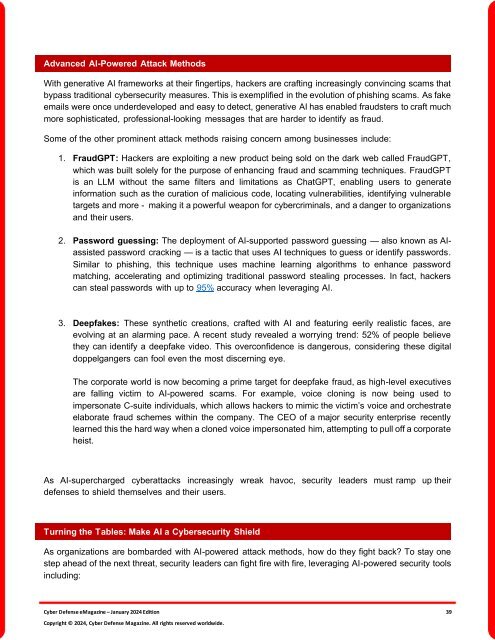The Cyber Defense eMagazine January Edition for 2024
Cyber Defense eMagazine January Edition for 2024 #CDM #CYBERDEFENSEMAG @CyberDefenseMag by @Miliefsky a world-renowned cyber security expert and the Publisher of Cyber Defense Magazine as part of the Cyber Defense Media Group as well as Yan Ross, Editor-in-Chief and many more writers, partners and supporters who make this an awesome publication! 201 page January Edition fully packed with some of our best content. Thank you all and to our readers! OSINT ROCKS! #CDM #CDMG #OSINT #CYBERSECURITY #INFOSEC #BEST #PRACTICES #TIPS #TECHNIQUES
Cyber Defense eMagazine January Edition for 2024 #CDM #CYBERDEFENSEMAG @CyberDefenseMag by @Miliefsky a world-renowned cyber security expert and the Publisher of Cyber Defense Magazine as part of the Cyber Defense Media Group as well as Yan Ross, Editor-in-Chief and many more writers, partners and supporters who make this an awesome publication! 201 page January Edition fully packed with some of our best content. Thank you all and to our readers! OSINT ROCKS! #CDM #CDMG #OSINT #CYBERSECURITY #INFOSEC #BEST #PRACTICES #TIPS #TECHNIQUES
You also want an ePaper? Increase the reach of your titles
YUMPU automatically turns print PDFs into web optimized ePapers that Google loves.
Advanced AI-Powered Attack Methods<br />
With generative AI frameworks at their fingertips, hackers are crafting increasingly convincing scams that<br />
bypass traditional cybersecurity measures. This is exemplified in the evolution of phishing scams. As fake<br />
emails were once underdeveloped and easy to detect, generative AI has enabled fraudsters to craft much<br />
more sophisticated, professional-looking messages that are harder to identify as fraud.<br />
Some of the other prominent attack methods raising concern among businesses include:<br />
1. FraudGPT: Hackers are exploiting a new product being sold on the dark web called FraudGPT,<br />
which was built solely <strong>for</strong> the purpose of enhancing fraud and scamming techniques. FraudGPT<br />
is an LLM without the same filters and limitations as ChatGPT, enabling users to generate<br />
in<strong>for</strong>mation such as the curation of malicious code, locating vulnerabilities, identifying vulnerable<br />
targets and more - making it a powerful weapon <strong>for</strong> cybercriminals, and a danger to organizations<br />
and their users.<br />
2. Password guessing: <strong>The</strong> deployment of AI-supported password guessing — also known as AIassisted<br />
password cracking — is a tactic that uses AI techniques to guess or identify passwords.<br />
Similar to phishing, this technique uses machine learning algorithms to enhance password<br />
matching, accelerating and optimizing traditional password stealing processes. In fact, hackers<br />
can steal passwords with up to 95% accuracy when leveraging AI.<br />
3. Deepfakes: <strong>The</strong>se synthetic creations, crafted with AI and featuring eerily realistic faces, are<br />
evolving at an alarming pace. A recent study revealed a worrying trend: 52% of people believe<br />
they can identify a deepfake video. This overconfidence is dangerous, considering these digital<br />
doppelgangers can fool even the most discerning eye.<br />
<strong>The</strong> corporate world is now becoming a prime target <strong>for</strong> deepfake fraud, as high-level executives<br />
are falling victim to AI-powered scams. For example, voice cloning is now being used to<br />
impersonate C-suite individuals, which allows hackers to mimic the victim’s voice and orchestrate<br />
elaborate fraud schemes within the company. <strong>The</strong> CEO of a major security enterprise recently<br />
learned this the hard way when a cloned voice impersonated him, attempting to pull off a corporate<br />
heist.<br />
As AI-supercharged cyberattacks increasingly wreak havoc, security leaders must ramp up their<br />
defenses to shield themselves and their users.<br />
Turning the Tables: Make AI a <strong>Cyber</strong>security Shield<br />
As organizations are bombarded with AI-powered attack methods, how do they fight back? To stay one<br />
step ahead of the next threat, security leaders can fight fire with fire, leveraging AI-powered security tools<br />
including:<br />
<strong>Cyber</strong> <strong>Defense</strong> <strong>eMagazine</strong> – <strong>January</strong> <strong>2024</strong> <strong>Edition</strong> 39<br />
Copyright © <strong>2024</strong>, <strong>Cyber</strong> <strong>Defense</strong> Magazine. All rights reserved worldwide.

















